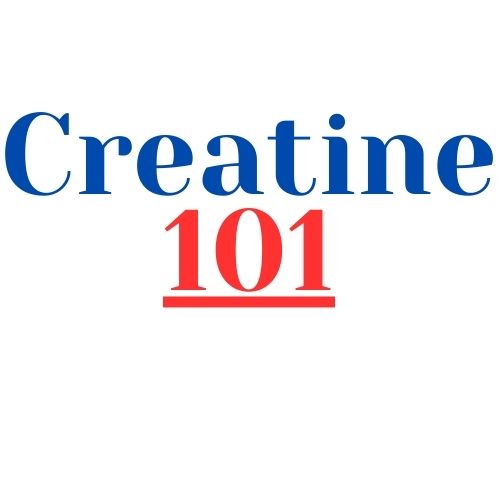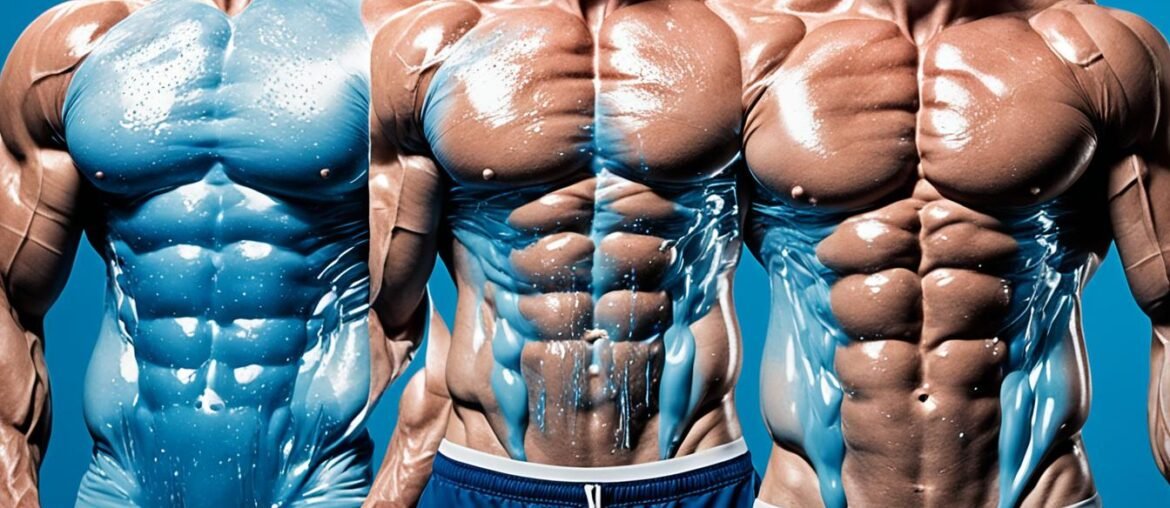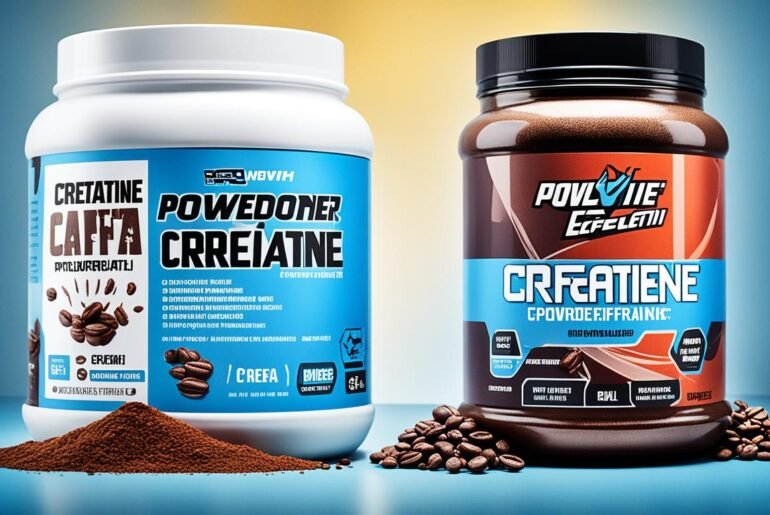In the realm of fitness supplements, few would expect that a compound as well-researched as creatine could lead individuals to experience an increase in body weight without a corresponding rise in body fat. Yet, this is precisely the case for many who undergo creatine supplementation. My exploration into the side effects of creatine, particularly focusing on creatine water retention, reveals a peculiar tale of physical transformation where muscles soak up not only strength but also copious amounts of water.
The crux of the matter rests on how our bodies handle increased amounts of muscle creatine. A typical creatine loading phase, which often involves consuming 20-25 grams of creatine per day over 5-7 days, can lead to a substantial rise in total body water (TBW). Surprisingly though, the usual distribution of fluids across compartments appears unaltered; what changes is the muscle’s capacity to retain water. This has implications for those I work with on managing water retention, as the perceived weight gain isn’t from burgeoning fat deposits, but largely bloating— an important distinction for any fitness enthusiast concerned about body composition.
Key Takeaways
- Enhanced muscle creatine levels are associated with water retention from creatine use.
- Weight gain during creatine supplementation is primarily due to increased water retention rather than fat.
- Monitoring body composition closely is key to managing water retention effectively.
- The creatine loading phase is identified as the primary period when water weight gain is most noticeable.
- Understanding the side effects of creatine can help individuals make informed decisions about their supplementation.
Understanding Creatine Supplementation and its Popularity
As a fitness enthusiast, I’ve witnessed firsthand the surge in popularity of creatine supplementation. This naturally occurring compound, critical for energy production in muscle cells, is more than just a fitness trend. Generated from the amino acids arginine, glycine, and methionine, creatine plays an essential role in my and many athletes’ health and performance regimens.
What is Creatine?
Exploring the roots of my supplementation routine, I find creatine at the core. It is a non-proteinogenic amino acid-like compound that helps to regenerate a high-energy molecule called adenosine triphosphate (ATP), which is the body’s main energy currency. This regeneration is particularly vital during short bursts of high-intensity activities such as sprinting or powerlifting.
Benefits of Creatine in Athletic Performance
The benefits of creatine in enhancing athletic performance are well documented and a key driver of its popularity. Through my experience and observations in the gym, I’ve seen how supplementing with creatine can lead to significant improvements in muscle size, strength, and power output. It is especially effective for improving performance in activities that require quick bursts of energy. As someone who enjoys high-intensity interval training, creatine supplementation is integral to my routine, helping me to push harder and recover faster.
Common Misconceptions and Safety Profile
Despite its widespread use, misconceptions about creatine persist. Detractors often claim creatine could lead to dehydration and kidney damage. However, the reality is that the safety profile of creatine is robust. My own experiences, supported by scientific research, confirm that when taken as directed, creatine supplementation does not cause harm to healthy kidneys or lead to dehydration. In fact, it’s often recommended as a safe and beneficial addition to an athlete’s diet.
Exploring the role of creatine in fitness has confirmed its value in helping me achieve my body’s peak performance. With its proven benefits and extensive safety records, creatine stands out as a supplement that not only enhances athletic performance but does so with consumer’s wellbeing in mind.
Exploring the Link Between Creatine and Water Retention
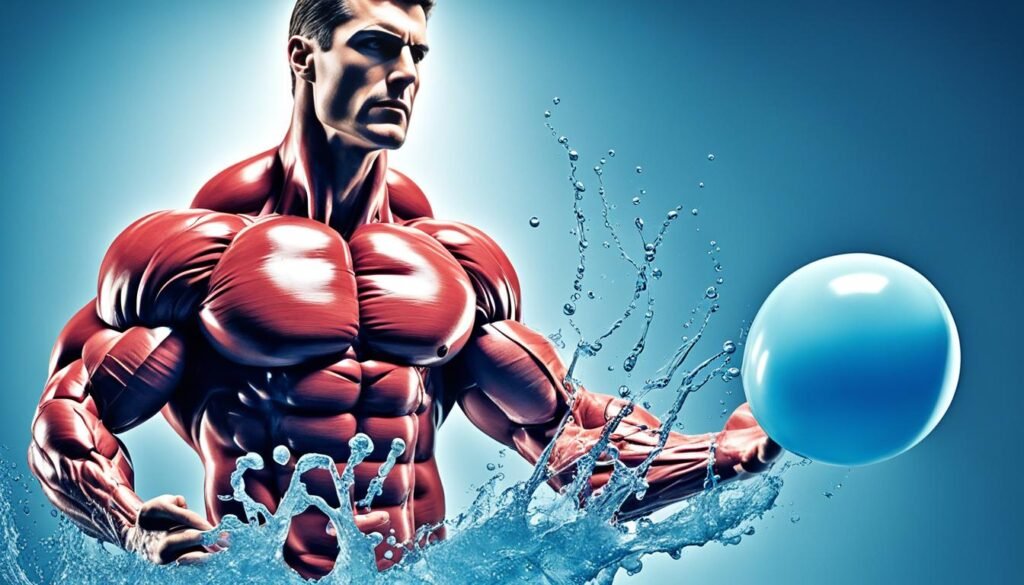
When we think about creatine and fluid retention, it is essential to address the correlation observed during the initial stages of supplementation. Many individuals report an increase in body weight, which is commonly referred to as water weight gain from creatine use. This is particularly pronounced during the loading phase where I might consume as much as 20-25 grams of creatine per day for about a week. This strategic intake is designed to maximize muscle creatine stores rapidly, a sought-after state by athletes and fitness enthusiasts for its potential to enhance muscle strength and performance.
To better understand the bloating effect that often accompanies this phase, it’s noted that the increased creatine levels create a draw of water into the muscles. This osmotic action pushes fluids from the bloodstream directly into the muscle cells, thus creating a temporary condition of fluid retention. Although most users might be concerned about the sudden jump on the scale, it is helpful to know that this body weight increase is not from fat, but predominantly from water that is retained within the muscle tissues.
My experience, paralleling numerous reports from others, confirms that the initial water retention is indeed temporary. Transitioning into the maintenance phase with a normalized creatine dosage gradually helps the body to adapt and eventually modulate the fluid levels.
In the subsequent article sections, I’ll delve into the scientific explanations for this phenomenon, provide insights on managing fluid retention while supplementing with creatine, and share some practical tips for balancing creatine intake to counteract water weight concerns.”
The Science of Creatine Water Retention
As a journalist with a focus on fitness supplementation, I’ve often explored the intricate dynamics of how various compounds affect the human body. When it comes to creatine, one of the most popular performance-enhancing supplements, understanding the science behind its side effects is crucial. The topic of creatine water retention science is particularly compelling, as it touches upon the physiological responses induced by creatine supplementation—responses that are both sought after by athletes and scrutinized by skeptics.
Mechanism Behind Water Retention From Creatine Use
My investigation into the underlying causes of water retention reveals that creatine has a pronounced effect on muscle hydration. Creatine’s molecular structure enables it to act as an osmolyte, a compound that influences the movement of water across cell membranes. When athletes ingest creatine, especially in the significant amounts involved in a loading phase, there’s a notable shift in intramuscular water content. This process, driven by creatine entering the muscle cells, results in an increase in intracellular volume, leading to the visible signs of water retention that many users report.
Evidence-Based Findings from Clinical Research
In the realm of clinical research on creatine, multiple studies have consistently demonstrated a link between creatine use and water retention. These findings are supported by quantitative measurements of body composition before and after creatine supplementation. By analyzing total body water, researchers have been able to confirm that the increase in body mass observed during the loading phase can be largely attributed to water retained in the body—and this has sparked a wave of continued research into optimizing creatine loading strategies for athletes.
Dissecting the science of creatine water retention not only enriches our understanding of this popular supplement but also informs responsible usage among athletes and fitness enthusiasts. It’s a topic that highlights the importance of considering every facet of supplementation, ensuring that the pursuit of peak performance is also a journey of health and informed choices.
Water Weight Gain: Separating Myth from Reality
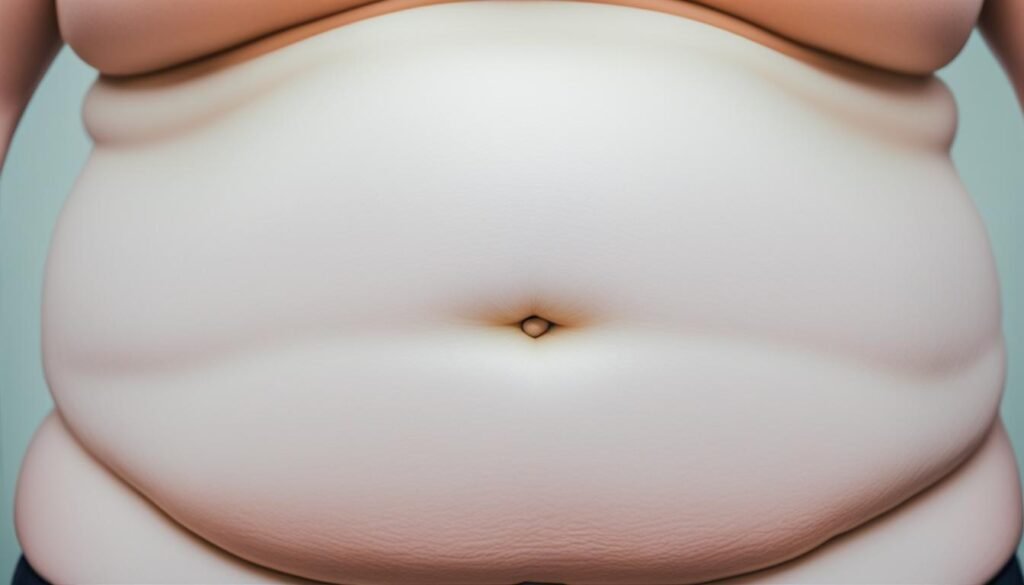
For many individuals using creatine supplements, the uptick on the scale can trigger a mix of confusion and concern – is it fat or simply water weight gain? As someone consistently analyzing these trends, I can assure you that the prevailing myths surrounding creatine and weight gain need to be addressed with clarity. Through rigorous studies, science has efficiently separated these myths from reality, underscoring a critical point: the weight gain linked to creatine use is water retention, not fat.
| Timeframe | Expected Water Weight Gain | Progression |
|---|---|---|
| Loading Phase | 2 – 4.5 pounds | Transient increase |
| Maintenance Phase | Minimal fluctuation | Stabilization or decrease |
I’ve examined countless cases where individuals report bloating from creatine use, especially during the initial loading phase. To demystify the process, it’s important to understand that this phase involves a significant, albeit temporary, spike in water intake within muscle tissue – a response to increased intracellular osmolarity brought on by heightened creatine levels. The observed water weight gain during this period is, as research dictates, a normal response rather than an indication of unwanted fat accumulation.
Remember, it’s not the number on the scale that we should fixate on, but the composition of that weight gain.
In my personal experience navigating through these nutritional intricacies, I’ve observed that water retention tends to subside as the body adapts and muscles become more conditioned. Moreover, the increased muscle mass from creatine use contributes to an overall improvement in metabolism, further mitigating any concerns about weight gain derived from fat. It’s essential for those supplementing their diet with creatine to maintain a broader perspective and recognize the temporary nature of water weight gain for what it truly is – a stepping stone to enhanced performance and physique.
Managing Water Retention While Using Creatine
When it comes to enhancing athletic performance, the use of creatine is widespread, but it often comes hand-in-hand with the issue of water retention. As a seasoned health and fitness enthusiast, I’ve come to understand the importance of effectively minimizing water retention to maintain peak condition. Below are some practical strategies I’ve identified to help reduce water retention while reaping the benefits of creatine supplementation.
Hydration Tips to Minimize Bloating From Creatine
Bloating and increased water weight can occur with creatine use, but there’s a counterintuitive method that works – increasing hydration. By enhancing your daily water intake, you effectively stimulate the body’s natural fluid removal system – urination – which can help to minimize water retention. Combining this with a mindful reduction in dietary sodium can greatly alleviate the sensation of bloating.
Adjustments to Creatine Dosage for Minimizing Water Retention
Another approach I’ve practiced with success is to bypass the conventional loading phase of creatine supplementation. Instead, I stick strictly to a maintenance dose of 3-5 grams per day. This adjustment aims to prevent the rapid water weight gain that often arises from higher dosages, without sacrificing the performance-enhancing effects of creatine.
| Daily Fluid Intake Recommendation | Benefits of Increased Hydration |
|---|---|
| Drink at least 3.7 liters for men and 2.7 liters for women | Promotes elimination of excess water and helps prevent bloating |
| Consume water consistently throughout the day | Supports metabolic processes and improves energy levels |
| Include hydrating foods, such as fruits and vegetables | Provides electrolytes and additional hydration to aid in reducing water retention |
As I continue to explore the synergies between creatine use and body hydration, my experience underscores the significance of a tailored approach. It’s not just about how to reduce water retention, but also how to optimize the use of creatine to support athletic performance while upholding a balanced fluid intake.
Balancing Creatine Intake: Loading Phase Versus Maintenance

When it comes to enhancing athletic performance through supplements, the use of creatine monohydrate has remained a staple in the fitness community. However, understanding the nuances of creatine loading phase and creatine maintenance phase can play a pivotal role in avoiding water retention—a common concern for many athletes.
Understanding the Loading Phase and Its Impact on Fluid Levels
The initial creatine loading phase is instrumental in quickly saturating the muscles with this potent compound. Typically, this period involves ingesting about 20-25 grams of creatine per day, divided into multiple doses for approximately a week. This method is known to cause a noticeable increase in fluid levels, primarily due to the osmotic effect creatine has on muscle cells, drawing water into them and leading to temporary weight gain from water retention. Here’s how this phase stands out:
- Rapid saturation: Aims to maximize muscle creatine stores in the shortest possible time.
- Increased body mass: Likely adjustment in scale weight due to additional intra-muscular water.
- Heightened hydration needs: Essential to increase water intake to manage excess levels of creatine.
Strategies for Avoiding Water Retention During the Maintenance Phase
Transitioning from the loading to the maintenance phase of creatine consumption is a strategic approach to mitigate the effects of water retention. The maintenance phase maintains the enhanced performance benefits while significantly reducing the amount of creatine intake to just 3-5 grams daily. While the phase shift results in a less pronounced effect on water retention, it preserves muscular ATP stores for prolonged performance enhancement. Let’s examine these strategies:
- Maintain a consistent intake of water to help balance the body’s fluids.
- Opt for a moderate creatine dose, foregoing the need for a loading phase.
- Monitor physical responses, adjusting dosage as needed to minimize water retention.
As we explore the balance between high-intensity performance and overall health, it is evident that the strategic modulation of creatine levels —from loading to maintenance— is vital. This helps individuals experience the benefits of increased power and muscle mass without the unnecessary bloating and discomfort associated with excess water retention.
Identifying and Addressing Side Effects of Creatine
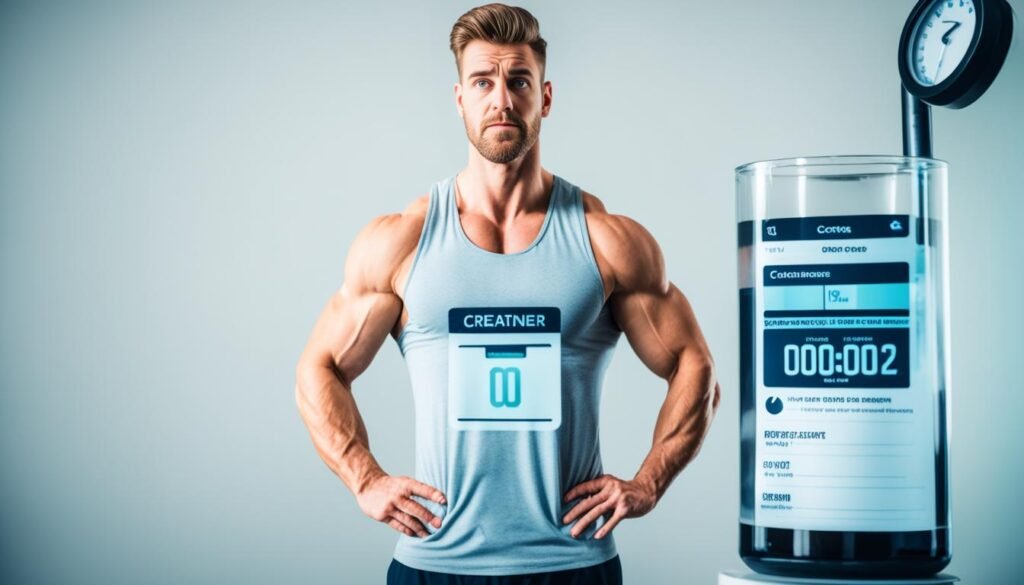
My experience with creatine supplementation, like many others, includes navigating the occasional side effect, especially pertaining to the side effects of creatine like muscle cramps and gastrointestinal issues. Understanding that managing water retention is a common concern, I have adopted strategies to counteract these undesired effects.
Muscle cramps can be particularly troublesome. They are often a signal from my body that I need to reassess my water intake or electrolyte balance. I learned that maintaining adequate hydration is crucial, not only for performance but also to minimize any discomfort from cramps. My rule of thumb is drinking at least half my body weight in ounces of water each day—with an additional 16 to 24 ounces for every hour of intense workout.
When it comes to gastrointestinal distress, such as bloating or an upset stomach, I found that gradually increasing creatine intake allowed my body to adapt without causing abrupt changes in my digestive system. Starting with a lower dose and steadily working up to the desired quantity can be a gentler approach.
Now, let’s talk about managing water retention. Again, hydration is your ally here. Furthermore, it may be beneficial to adjust the sodium in your diet and increase activity to keep fluids moving through your body efficiently.
| Side Effect | Managing Strategy | Personal Observation |
|---|---|---|
| Muscle Cramps | Increased hydration & balanced electrolytes | Reduced incidence when well-hydrated |
| Gastrointestinal Issues | Gradual creatine supplementation | Less bloating with a gradual increase |
| Water Retention | Hydration, diet adjustment, increased activity | Effective fluid management & less bloating |
In my own regimen, tracking the side effects enables me to make informed adjustments. It is crucial, though, to remain aware of any potential drug interactions with current medications. Consulting with a healthcare professional before beginning or modifying creatine usage is always a necessary step.
If you’re currently experiencing any of these side effects, you might consider similar adjustments. And, of course, the input of a nutritionist or a professional trainer can offer bespoke advice to help you navigate the side effects of creatine while maximizing its benefits.
Optimal Creatine Forms to Reduce Fluid Retention
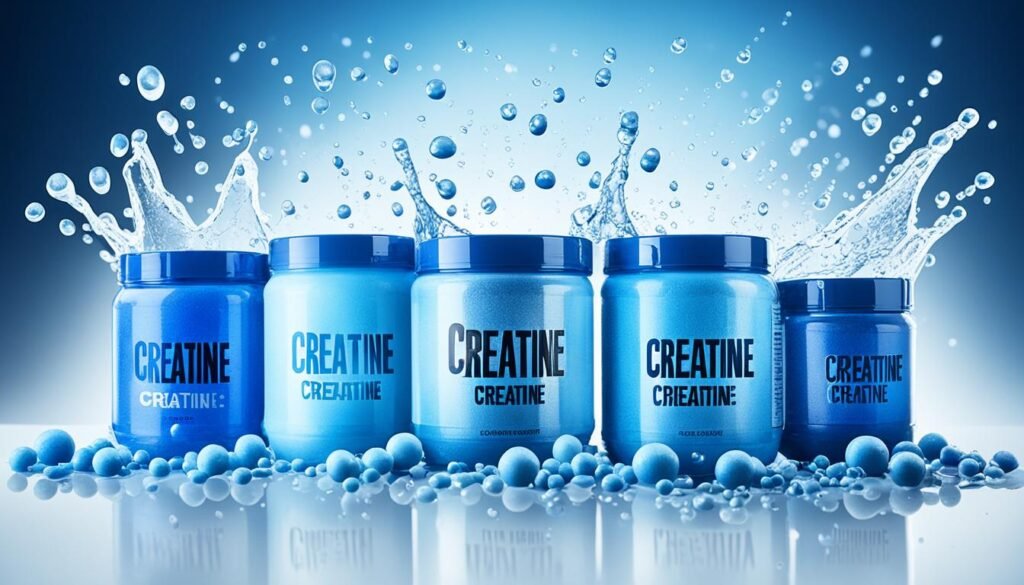
When investigating methods for reducing fluid retention associated with creatine supplements, I have encountered a plethora of options. However, through my research and experience, I’ve found that creatine monohydrate stands out from the crowd. This form is not only highly researched but also known for its efficacy and safety, making it one of the most effective creatine forms available.
Many alternatives to creatine monohydrate have been marketed, purporting lower risks of water retention and faster absorption. Yet, time and again, studies have shown that these claims do not hold up against the performance and reliability of creatine monohydrate.
Creatine Monohydrate Versus Other Forms
For those of us concerned with bloating or excess water gain, creatine monohydrate offers an ideal balance. It’s not only about its ability to saturate muscle creatine stores efficiently but also about how it interacts with our bodies to mitigate unwanted water retention.
Effectiveness and Absorption Rates
The superiority of creatine monohydrate comes down to its absorption rate. While other forms may claim to be superior, the near-perfect absorption rate of creatine monohydrate is hard to beat. This ensures that your body is utilizing the supplement effectively without unnecessary byproducts that might contribute to fluid retention.
| Creatine Form | Absorption Rate | Cost | Risk of Fluid Retention |
|---|---|---|---|
| Creatine Monohydrate | High | Low | Lower |
| Creatine Ethyl Ester | Variable | Medium | Higher |
| Buffered Creatine | High | High | Moderate |
| Liquid Creatine | Lower | High | Higher |
| Creatine Hydrochloride (HCl) | High | Medium | Lower |
As you peruse this table, it’s evident that while other forms may seem promising, creatine monohydrate emerges as the cost-effective and efficient choice for athletes and bodybuilders aiming to enhance their performance without the drawback of substantial water retention.
Implementing Lifestyle Changes to Manage Water Weight Gain
As I venture into the realms of optimized supplementation, I’ve recognized that integrating thoughtful lifestyle adjustments is vital for managing water weight when using creatine. To harmonize with this potent muscle-building aid, I’ve discovered that both diet and exercise hold the keys to controlling the water retention effects commonly experienced by many fitness enthusiasts and athletes alike.
The Role of Diet in Managing Water Retention
My journey has taught me that the role of diet in water retention is significant. By reducing my intake of high-sodium foods and moderating my consumption of carbohydrates, I effectively support my body’s natural balance. These dietary choices assist in managing the water retention that occasionally surfaces with creatine consumption. The changes don’t just reflect on the scales but also in how my physique appears and feels, affirming the importance of lifestyle changes for managing water weight.
Exercise’s Effect on Creatine-Induced Water Retention
Moreover, the impact of regular, structured exercise cannot be overstated when it comes to exercise’s effect on water retention. As I commit to consistent workout routines, my body adapts to the increased creatine levels, gradually reducing the initial bloating. This adaptation not only alleviates the water retention but also drives muscle definition and promotes the accrual of strength gains, turning a temporary side effect into a long-term physical advancement.
FAQ
What causes water retention from creatine use?
Water retention from creatine use is typically caused by the creatine drawing water into muscle cells to aid in ATP replenishment. This can lead to increased intracellular hydration and a bloating effect during the initial loading phase of supplementation.
What are the benefits of creatine in athletic performance?
Creatine supplementation is known to enhance muscle size, strength, and power. It supports energy-intensive activities such as weightlifting and sprinting by playing a vital role in the regeneration of ATP within muscle cells.
Are there any common misconceptions about creatine?
Yes, a common misconception is that creatine causes dehydration and kidney damage. However, research has shown that creatine has a strong safety profile, and when used responsibly, does not generally lead to these adverse effects.
How can I reduce water retention while using creatine?
To reduce water retention, it is recommended to increase hydration, limit sodium intake, and possibly skip the loading phase by taking a maintenance dosage of 3-5 grams per day, which may help avoid rapid fluid gains.
What is the impact of the creatine loading phase on fluid levels?
The loading phase, which involves a higher dosage of creatine (20-25 grams daily) for 5-7 days, is designed to rapidly saturate muscle stores with creatine. This often results in a temporary increase in total body water and body weight due to water retention.
Can dietary adjustments help manage water retention from creatine?
Yes, making dietary adjustments such as reducing high-sodium foods and excess carbohydrates can help manage fluid retention. Consistent exercise can also help the body acclimate and reduce the extent of water retention over time.
Is creatine monohydrate the best form to reduce fluid retention?
Creatine monohydrate is the most researched form and has been shown to have near-perfect absorption rates. While different forms of creatine exist, creatine monohydrate is effective and economical and is commonly recommended for its proven benefits.
What are some side effects of creatine?
Some potential side effects of creatine may include muscle cramps, gastrointestinal distress, and increased water retention. It is important to adjust creatine dosage, maintain good hydration, and be aware of any drug interactions if they arise.
How can exercise influence creatine-induced water retention?
Regular exercise helps the body adjust to creatine supplementation, potentially reducing the bloating effect and helping to enhance muscle definition and strength gains as water retention diminishes.
What strategies can be used to avoid water retention during creatine maintenance phase?
During the maintenance phase, a consistent lower dose of 3-5 grams of creatine per day can help avoid excessive water retention. Additionally, staying well-hydrated and managing diet and exercise could aid in minimizing any fluid-related weight gain.
